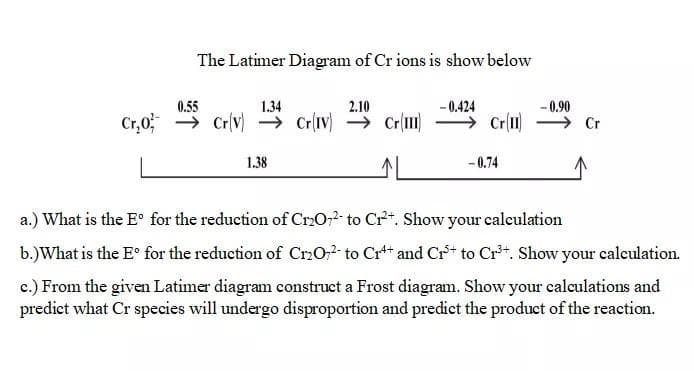The Latimer Diagram of Cr ions is show below 0.55 1.34 2.10 -0.424 - 0.90 Cr,0 → Cr{v) → Cr(Iv) Cr(1) → Cr[1) → Cr 1.38 - 0.74 a.) What is the E° for the reduction of Cr.O;2- to Cr*. Show your calculation b.)What is the E° for the reduction of CrzO,2- to Crt and Cr+ to Cr. Show your calculation. c.) From the given Latimer diagram construct a Frost diagram. Show your calculations and predict what Cr species will undergo disproportion and predict the product of the reaction.
The Latimer Diagram of Cr ions is show below 0.55 1.34 2.10 -0.424 - 0.90 Cr,0 → Cr{v) → Cr(Iv) Cr(1) → Cr[1) → Cr 1.38 - 0.74 a.) What is the E° for the reduction of Cr.O;2- to Cr*. Show your calculation b.)What is the E° for the reduction of CrzO,2- to Crt and Cr+ to Cr. Show your calculation. c.) From the given Latimer diagram construct a Frost diagram. Show your calculations and predict what Cr species will undergo disproportion and predict the product of the reaction.
Chemistry: Principles and Reactions
8th Edition
ISBN:9781305079373
Author:William L. Masterton, Cecile N. Hurley
Publisher:William L. Masterton, Cecile N. Hurley
Chapter17: Electrochemistry
Section: Chapter Questions
Problem 106QAP: In biological systems, acetate ion is converted to ethyl alcohol in a two-step process:...
Related questions
Question

Transcribed Image Text:The Latimer Diagram of Cr ions is show below
0.55
1.34
2.10
- 0.424
- 0.90
Cr,0 Cr(v) → Cr(iv) → Cr(1)
Cr(11)
Cr
1.38
- 0.74
a.) What is the E° for the reduction of Cr2O,2 to Crt. Show your calculation
b.)What is the E° for the reduction of CrO, to Cr** and Cr* to Cr**. Show your calculation.
c.) From the given Latimer diagram construct a Frost diagram. Show your calculations and
predict what Cr species will undergo disproportion and predict the product of the reaction.
Expert Solution
This question has been solved!
Explore an expertly crafted, step-by-step solution for a thorough understanding of key concepts.
This is a popular solution!
Trending now
This is a popular solution!
Step by step
Solved in 4 steps with 3 images

Knowledge Booster
Learn more about
Need a deep-dive on the concept behind this application? Look no further. Learn more about this topic, chemistry and related others by exploring similar questions and additional content below.Recommended textbooks for you

Chemistry: Principles and Reactions
Chemistry
ISBN:
9781305079373
Author:
William L. Masterton, Cecile N. Hurley
Publisher:
Cengage Learning

Principles of Modern Chemistry
Chemistry
ISBN:
9781305079113
Author:
David W. Oxtoby, H. Pat Gillis, Laurie J. Butler
Publisher:
Cengage Learning

Chemistry: The Molecular Science
Chemistry
ISBN:
9781285199047
Author:
John W. Moore, Conrad L. Stanitski
Publisher:
Cengage Learning

Chemistry: Principles and Reactions
Chemistry
ISBN:
9781305079373
Author:
William L. Masterton, Cecile N. Hurley
Publisher:
Cengage Learning

Principles of Modern Chemistry
Chemistry
ISBN:
9781305079113
Author:
David W. Oxtoby, H. Pat Gillis, Laurie J. Butler
Publisher:
Cengage Learning

Chemistry: The Molecular Science
Chemistry
ISBN:
9781285199047
Author:
John W. Moore, Conrad L. Stanitski
Publisher:
Cengage Learning

Chemistry for Engineering Students
Chemistry
ISBN:
9781337398909
Author:
Lawrence S. Brown, Tom Holme
Publisher:
Cengage Learning

Principles of Instrumental Analysis
Chemistry
ISBN:
9781305577213
Author:
Douglas A. Skoog, F. James Holler, Stanley R. Crouch
Publisher:
Cengage Learning

Chemistry
Chemistry
ISBN:
9781305957404
Author:
Steven S. Zumdahl, Susan A. Zumdahl, Donald J. DeCoste
Publisher:
Cengage Learning